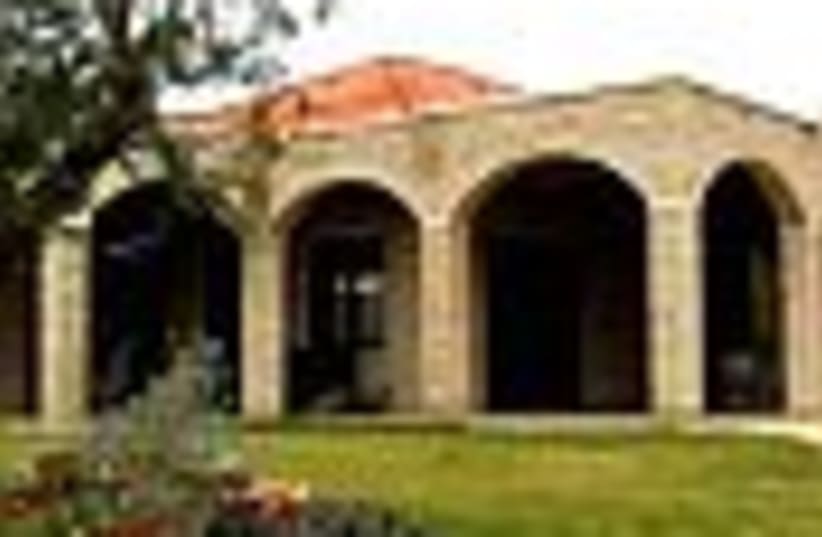By the time economist Yossi Shamir returned from his stint as an aliya emissary for the Jewish Agency in Australia, he had brought several new immigrants to Israel - as well as an entirely new way of building houses.
Explains his daughter Dalit, whose house was built by the company which her father founded, Austec-Shamir: "My father was very impressed with the materials used in construction, the short time it took to build and the high level of finish. He felt it would help the absorption of immigrants if their homes were something with which they were familiar."
Dalit's home, where she lives with her husband, two small children and Sonia the Labrador, epitomizes the construction method used by the company, which was founded 14 years ago and in which she worked in the sales and marketing department.
The steel girders which form the basis of the building are actually left visible in this house as a decorative element. Inside the walls are several layers of insulation including plasterboard and air pockets.
"It's very different from the conventional building method here which consists of blocks with plaster on the outside and color on the inside," she says. "For the brick-laying, which, incidentally, is considered a prestigious profession in Australia, we use a family of three generations of builders, the Marciano family, and they achieve a very professional finish."
For the design of their home, on a moshav north of Netanya, the couple turned to old school friends, architects Sharon and Yoav Michael, to translate their ideas into a practical living space.
"I wanted clean simple lines, no clutter and no pitchifkes (knick-knacks)," says Dalit. "Outside we wanted it to look simple, even homely, with square straight lines and no ostentation."
Because of the simplicity of the outside, the impact of the inside is quite dramatic. The front door opens onto a large space with a very high sloping ceiling, glass walls and the most extraordinary light fittings.
"I approached Shlomo Harush, a well-known industrial artist, and asked him to create us something which would be very dominant and fill the huge space. Usually he is known for his sculptures and paintings, not for light fittings."
"He came to look at the house under construction and said 'Give me two days here alone.' We did and left him here, on his own for the two days. We came back and opened the door. The house was completely dark and then he switched on the lights. I was shocked, stunned, amazed. I said to my husband, 'I have Christmas trees growing out of my ceiling.' Now I think it's perfect, but I confess that was not my first reaction."
They grew to like it so much they also asked Harush to make them a mirror, a large, rectangular, embossed stainless steel object which hangs at the entrance.
Use of raw materials in unlikely places is a feature of the house and important to the owners. The deep angle of the ceiling is made of chipboard, pieces of wood compressed together and left in their natural state. A wall dividing the living area from the bedrooms has been created by grey bricks which stand on their sides so the cement holes show, creating an interesting and different effect.
The open kitchen is a dark grey topped with butcher block work surfaces.
"A lot of thought went into the colors of the kitchen," says Dalit. "I loved the combination but felt it was cold and needed the warmth of the wooden windows for contrast. And although I considered raw concrete for the floor, I decided that would be too rough and opted for local Mitspe stone instead."
The lounge is quite cozy in spite of the steel girders, the air-conditioning tunnel which encircles the room under the ceiling, and the walls of raw concrete. The softening affect is achieved by stylish Italian furniture, a green glass dining table and the grey drapes. Children's toys scattered around help as well. Outside, the small garden and decks are visible through the wall-to-ceiling windows.
To get to the master bedroom one passes through a frosted glass door set in a dark iron frame. The room has a connected bathroom with no doors - "very non-Feng Shui," says Dalit, who at least tries to keep the toilet seat down to prevent good energies from going down the drain.
The children's rooms are on the other side of the brick wall and their bathroom is a cheerful medley of colors, with each wall and half wall tiled in a separate shade - red, blue, white, yellow, green and black. "A little bit retro," says Dalit.
It's the only part of the house that is. The rest is as modern as it gets.
Do you feel you own one of Israel's most beautiful homes? Please e-mail gloriadeutsch@gmail.com.
.>
| More about: | Ariel Harush, Jewish Agency for Israel, Australia, Netanya |
